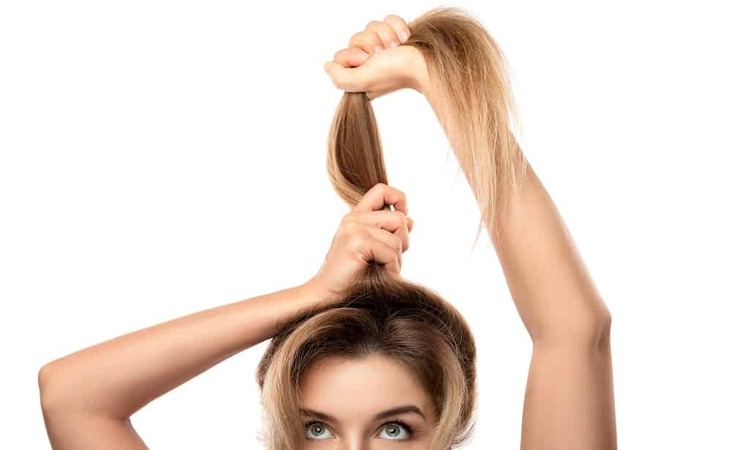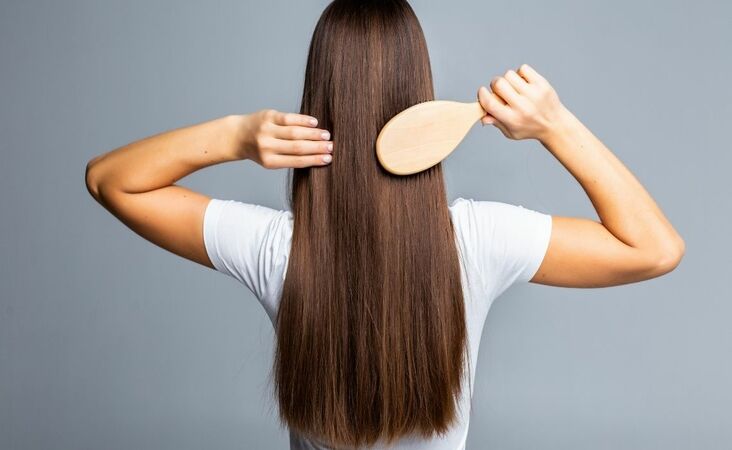Disturbed Hair Shedding Cycle: Stages, Causes, and Recovery
- Written by Victor Lordhair
- Nov 23, 2022
- |
- 11 min read
 Listen to the full text
Listen to the full text
Hair shedding happens to us all. Just like skin, hair strands go through different stages and shed in cycles. While it’s normal to lose around 100 hair strands a day, losing a lot more than that could be a sign of a disturbed hair-shedding cycle.
A lot of men and women have no clue about what causes a disturbance in the hair-shedding cycle. If you are one of them, we highly suggest reading this blog to the end! Lordhair - a leading hair toupee brand - is here to talk about the hair shedding cycle, its signs, causes, stages, and treatments.
Don’t have enough time to read the complete blog? Fear not. We have prepared a FAQ version for you!
What are the different stages of the hair shedding cycle?
Here are four different stages involved in the hair shedding cycle:
- Anagen
- Catagen
- Telogen
- Exogen
What are the causes of disturbed hair cycle shedding?
There are plenty of reasons behind disrupted hair shedding in men and women. Some common ones are:
- Dieting for weight loss
- Childbirth
- Stress
- Medical conditions
- Surgery
What are the best treatments to fix the hair shedding cycle?
The following treatments will help men and women fix their disturbed hair-shedding cycle and bring it back to normal:
- Medications
- Low-level laser therapy
- Hair system
- Positive lifestyle changes
Now that we are done with the TL;DR version, let’s learn about the hair shedding cycle in detail.
What Are the Different Stages of the Hair Shedding Cycle?
We believe that it is important to understand the different stages of the hair-shedding cycle before discussing the causes. Learning about them will make it easy for men and women to identify issues that they have been encountering with their hair.
There are four different stages of the hair-shedding cycle. Each strand goes through them at its own pace. Let's learn about them:
Anagen: Anagen is the first stage of a hair lifecycle. Also called the growth phase, the hair grows half an inch every month in this stage. Anagen lasts about three to five years, making it the longest phase. However, in some men and women, especially Asians, this phase could go on for up to seven years. The average full-hair length that one can grow during the anagen phase is around 18 to 30 inches.

Catagen: Here comes the shortest stage of the hair-shedding cycle! Catagen starts when the anagen phase ends. Better known as the transitional phase, it tends to last about 10 days or so. During this phase, the outer section of the root (hair follicles) shrinks, allowing club hair (strands with a bulb of keratin at the root tip) to emerge. Only 3% of scalp strands stay in the transitional phase at one point in time.
Telogen: Hair follicles are entirely in hibernation during the telogen stage of the hair cycle. Strands don’t develop during this phase but they also don’t fall out. The telogen stage lasts for about three months and impacts 10-15% of human hair at a specific period.
Exogen: In the final stage of the hair shedding cycle, our hair begins to cut off from the follicles and drops out. This is the reason why exogen is also called the shedding phase. Exogen can last about two to five months. Thankfully, new strands continue to emerge from follicles after old ones drop off.
A comprehensive guide on hair shedding vs hair loss
What Are the Causes of Disturbed Hair Cycle Shedding?
When the scalp sheds hair strands aggressively on a daily basis, it is a sign of a disturbed hair cycle shedding. There are plenty of reasons that can disrupt the shedding cycle in men and women. Some of these are as follows:
#1 Dieting for weight loss
Hair follicles are one of the most metabolically active tissues in the human body. They often get affected when one reduces caloric and protein intake or forms a micronutrient deficiency in order to lose body weight. Dieting can disrupt the hair growth cycle and make a lot of strands shift unexpectedly from the anagen phase to the telogen phase.
#2 Childbirth
Many new mothers notice excessive hair shedding a few months after giving birth. This occurs because of hormonal changes in the body. Pregnancy hormones cause many strands to enter into the resting phase. Though it may be distressing to have a disturbed hair-shedding cycle for women, the good news is that it is temporary.
Hair shedding in women lasts around five to six months after childbirth.
#3 Stress
We bet most of our readers might be thinking, “Wait, stress is also a cause of a disturbed hair-shedding cycle?” Sadly, that’s a fact. When we feel stressed, our body begins to experience a boost in cortisol levels. Cortisol is a primary stress hormone released from the adrenal glands which sit on the top of our kidneys.
When the primary stress hormones come in contact with other hormones, hair strands sometimes go into the resting phase, making them susceptible to falling out. Besides disrupting the hair-shedding cycle, stress can also make men and women scratch their scalps more which further weakens hair from the roots.

#4 Medical conditions
Dermatologists state that many illnesses occasionally trigger hair shedding in men and women by transferring a plethora of hair follicles straight into the exogen phase. People usually begin to notice excessive hair fall a few days after becoming ill. Broken strands on the pillow and between fingers are common signs of a disturbed hair-shedding cycle caused by medical conditions.
Medicines consumed for treating certain medical conditions also trigger excessive hair shedding among males and females.
#5 Undergoing surgery
Yes, you guys read it right! One may experience aggressive hair shedding after undergoing surgery. Why? Surgeries can be traumatic and tend to put us under substantial physiological stress. It is speculated that stress plays the part of a trigger that signals the hair follicles to lay torpid or enter the telogen phase.
However, there’s no need to worry. Once the body starts to recover, the disturbed hair cycle normalizes.
Learn more about hair shedding causes and treatments for men
What Are the Best Treatments to Fix a Disturbed Hair Shedding Cycle?
The good news for men and women experiencing a disturbed hair-shedding cycle is that the change is temporary and the normal hair growth cycle tends to revert back over a period of a few months.
In case you want to shorten the period of disturbed hair shedding cycle, we suggest considering the following treatments and lifestyle changes to stop excessive hair shedding:
#1 Medications for recovery
There are FDA-approved oral medications and topical solutions that are engineered to tackle hair loss that’s related to hormonal changes and medicines. Since most hair loss medications come with side effects, we don’t recommend taking them without first consulting a doctor.
#2 Low-level laser therapy
Low-level laser therapy is a safe, non-invasive, and clinically proven treatment used for fixing a disturbed hair shedding cycle in men and women. A powerful clinical-strength laser device is pointed at the affected areas of the scalp first. It then irradiates low-level photons into the scalp tissue, enabling them to be soaked by weaker cells.
As a result, low-level laser therapy helps cells to regain functionality such as hair growth and allows them to return to their regular processes.
#3 Hair systems
The aforementioned treatments may not do wonders for everyone. For men who have experienced major hair loss and damage, Lordhair suggests using hair systems. Unlike medications and low-level laser therapy, hair systems (also known as toupee hair replacement systems, hairpieces, and wigs) are non-surgical, cheap, and have zero side effects. Comfortable, breathable, and durable, they appear ultra-realistic and give the appearance of real hair growing from the scalp.
Check out how amazing Chris looks after trying a Lordhair hair replacement system:
#4 Lifestyle changes
Now, this may sound a little strange to some of our readers but lifestyle factors such as diet, smoking, sleep, and styling can also disturb your hair shedding cycle. Consider these lifestyle factors in order to improve scalp hair growth in 2023:
- Make changes in your diet - include healthy foods that are rich in minerals and vitamins to help in reversing hair shedding
- Quit smoking and drinking as both reduce blood flow to the scalp causing damage to the DNA of hair strands and affecting their growth cycle
- Get the right amount of sleep and also stick to one waking time
- Reduce the use of heat-focused styling equipment such as iron rods and hairdryers

Disturbed Hair Shedding Cycle: Final Words
Above are treatments and lifestyle changes that can help men and women fix a disturbed hair shedding cycle and bring the duration of different phases (anagen, catagen, telogen, and exogen) back to normal. A lot of times, hair shedding is temporary. So, if you see broken strands here and there, there’s no need to panic.
However, if your hair shedding cycle doesn't improve and strands still seem everywhere, consider it a sign of hair loss. We advise men and women to speak to a dermatologist to determine the cause behind their hair condition. Use hair systems in case your hair loss or thinning is extreme.
Lordhair designs and supplies the world’s best range of stock and custom hair units to more than 100 countries. Our non-surgical hair recovery products are made of high-quality materials and come with a 30-day money-back warranty.
Got any queries for us? Send them to support@lordhair.com and have them answered by our hair experts.
Also, check out:
- Everything about scalp psoriasis hair loss
- A complete guide on plica polonica
- Discover partial hairpieces for receding hairlines
- Volume hair toppers to look your best
- Discover human hairpieces at great discounts
- Bald actors who have worn toupees for roles


